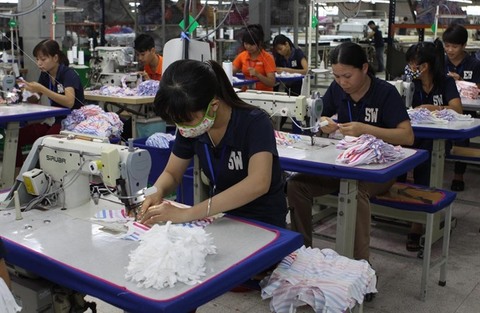
Apparel is made for export at Norfolk Hatexco Joint Stock Company at Dong Van 1 Industrial Park in the northern province of Ha Nam’s Duy Tien District. — VNA/VNS Photo Vu Sinh
The Europe–Viet Nam Free Trade Agreement (EVFTA) is expected to create momentum for the domestic textile industry to develop in the future, experts said.
The signing of the EVFTA is in the final stages and, with the goodwill of the two sides, the agreement is expected to be finalised this year, according to Deputy Prime Minister Vuong Dinh Hue.
When the EVFTA is signed, the export tariff to the EU will reduce to zero from the current high rates of 7-17 per cent, said Vu Duc Giang, chairman of the Textile and Apparel Association. Therefore, the growth rate of garment exports from Viet Nam to the EU market is predicted to reach 7-8 per cent per year.
In 2017, Viet Nam’s textile and garment export turnover reached US$31.16 billion, a year-on-year increase of 10.23 per cent, Giang said, including $3.79 billion from the EU, a year-on-year surge of 6.3 per cent.
The target of $35 billion for 2018’s exports is feasible as a result of the major role played by the free trade agreements in the development of garment exports.
In addition, an optimistic EU economic outlook is also a positive signal for the development of the local textile and apparel industry.
Therefore, the EU - the second largest import market of the textile and garment sector, after the United States - is expected to help the local textile and garment industry grow strongly this year, he said.
Viet Dragon Securities Joint Stock Company (VDSC) commented that in the case of stability in the global economy, especially in the EU, the difficulty associated with having orders similar to 2016 would not be repeated, reported ndh.vn online newspaper.
VDSC said companies that will likely have high turnover in garment exports to the EU market are Saigon Garment Manufacturing Joint Stock Company, TNG Investment and Trading Joint Stock Company, Garment 10 Corporation and Viet Tien Garment Joint Stock Company, with high growth in export orders compared with other firms.
Vo Van Kien Nhan, head of the domestic sales department and deputy director of Viet Tien Garment JSC’s branch in Ha Noi, said the export opportunity to the EU is significant because of the EVFTA agreement, which will help the company confirm its position in the global market. However, the company would face tough competition from foreign brands, such as Zara and H&M, and must share the local market with other domestic firms.
Meanwhile, Nguyen Thi Thu Trang, director of the WTO Integration Centre under the Viet Nam Chamber of Commerce and Industry, said it is not easy to make use of opportunities offered by the EVFTA because the local garment industry must deal with many technical barriers for its products exported to the EU, including standards of production, packaging and labeling.
Local businesses can overcome tariff barriers, but it is unlikely to overcome technical barriers without extensive preparations because the EU is well known for being a fastidious market, Trang said.
In particular, local exporters will face difficulties in meeting the requirements of the rules of origin. At present, most textile materials from Viet Nam’s textile and garment industry do not originate from EU member countries, so they cannot take advantage of the preferential tariffs.
She said the greatest challenge for the domestic textile and garment industry in the coming period is the development of domestic materials. This is also an opportunity to attract foreign investors to take full advantage of the EVFTA. — VNS